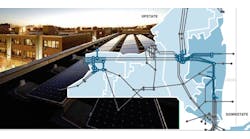In a filing before the Federal Energy Regulatory Commission (FERC), Alternative Transmission (ATI) proposes a technology that could bring a new meaning to the concept of non-wires alternatives.
Based in Sullivan’s Island, S.C., the company wants to move batteries by rail for discharge and charge where needed on the electric grid. Further, ATI asks FERC to declare that its facilities and services are transmission resources operating in interstate commerce and, therefore, subject to FERC jurisdiction. The owner of such facilities should be considered a public utility under the Federal Power Act, the company argues.
That alone would make the petition unusual. “Most people try to avoid being regulated as a utility,” says James Mitchell, a partner with Davis Wright Tremaine. The technology application is also unusual. “It is very creative, very innovative,” Mitchell says.
Non-wires alternatives on the move
…ours can go where traditional transmission lines cannot necessarily go — ATI
In its petition, ATI says its technology involves the “construction of energy transfer stations — charging and discharging — at locations in the continental United States.”
“It is a transmission circuit, like any other,” says Adam Rousselle, president and CEO of ATI. “The difference is that ours can go where traditional transmission lines cannot necessarily go.”
The charging would be done by unaffiliated entities. The energy transfer, the transmission aspect of the technology, would be accomplished by a sort of disaggregated flow battery.
Flow batteries create an electric charge by moving tanks full of electrolytic solutions with opposite electrical charges between a membrane.
ATI would ship charged electrolytic solution via railcars or other modes of transportation to a destination that is either remote, has suffered a disruption to electrical service or where the cost of electricity is higher than at the charging station.
At the discharging station, the energy-carrying fluid would be available for “instantaneous dispatch as instructed, until the charge is depleted, and the medium becomes available for recharge,” according to the petition. Unlike battery storage, the energy could flow as long as the railcars of electrolyte were rolling.
“Flow batteries are not yet economic, but if they are disaggregated they can be made to fit into the economic model that already exists for transmission,” Rousselle says.
One possible application could be to use ATI’s service to create microgrids in places with little or no traditional transmission service.
Competing against the titans
But why seek out FERC regulation? It is ATI’s effort to level the playing field so it can compete in wholesale power markets against the well established titans of electric transmission.
In the petition, ATI says it wants to “invest in alternative modes of transmission with the commission’s assurance that it will be able to compete fairly with traditional wire and wire corridor modes of transmission.”
ATI’s petition would seem to land squarely within FERC’s backing for field-leveling demonstrable in its landmark decisions in which it sought to level the playing field for transmission and energy storage, orders 1000 and 841, respectively. But ATI’s petition is also attracting some heavyweight opposition.
“…the same transmission status could be conferred on electric vehicles that charge in one state and discharge in another — EEI
In filed comments, the Edison Electric Institute, a utility trade group, wrote that ATI’s petition should be denied because it does not specify the services ATI proposes to provide, and it “raises jurisdictional issues that it fails to address adequately.”
Those jurisdictional issues have “widespread implications,” says EEI that FERC should “refrain from addressing in a proceeding involving an individual petition for declaratory order.”
As ATI notes in its petition, the Federal Power Act refers to electric “lines,” but never mentions “wires.” EEI concedes the narrow point, but argues that “legislative history” shows that Congress had wires in mind when it drafted the legislation.
EEI also argues that FERC has “long recognized” that it is inappropriate to extend its jurisdiction to modes of transportation regulated by other entities, such as railroads, oil pipelines and motor vehicles, which all fall under the jurisdiction of other federal regulators.
To that point, EEI raises the question that if ATI were found to be jurisdictional to FERC, then the same transmission status could be conferred on electric vehicles that charge in one state and discharge in another.
By Igor Klyakhin/Shutterstock.com
Definition: Non-wires alternatives use distributed energy resources and microgrids to defer or replace the installation of more traditional ‘wires and poles’ infrastructure. When utilities choose non-wires alternatives, they often save ratepayers money by avoiding investments in costly infrastructure. Read more about non-wires alternatives here.
A similar argument is made by the American Public Power Association. In its filed comments, the APPA argues that the 1973 finding by the Federal Power Commission — a precursor to FERC — that it did not have jurisdiction under the Natural Gas Act over the transportation of liquefied natural gas by methods other than pipeline is “instructive in evaluating ATI’s Petition,” the trade group wrote, adding, “a similar analysis supports a finding that ATI’s alternative transmission service is not subject to the Commission’s jurisdiction.”
And while it says it supports “new technologies and innovation,” the APPA says ATI’s petition is “insufficiently developed and, at best, premature.” APPA adds that “virtually no information is provided about ATI itself, let alone any indication that it would have the resources to implement the kinds of services discussed in the petition.”
Threatens Texas energy sovereignty?
Another implication of ATI’s petition is not lost on Texas entities. In the existing regulatory environment, Texas does not fall under FERC jurisdiction. In its filed comments, the Public Utility Commission of Texas (PUCT) argues that ATI’s petition raises “serious issues” about Texas regulatory sovereignty. If FERC were to grant ATI’s petition, it would “create considerable uncertainty about the [Electric Reliability Council of Texas] jurisdictional status quo,” the PUCT argued.
The regulator adds that transfer of an electrically charged medium, such as ATI is proposing, does not involve the “physical flow of electric energy” and provides “reason, in and of itself,” to deny the petition.
Even a developer of merchant transmission projects appears to be wary of ATI’s proposal. In its filed comments, LS Power requests FERC “narrowly tailor” its decision to “the specific facts presented by ATI.” In this time of technological advancement in the bulk power system, “broad holdings can have unintended consequences,” LS Power argues.
There is no deadline for FERC to make a decision on ATI’s proposal.
Track news about non-wires alternatives. Subscribe to the free Microgrid Knowledge newsletter.







